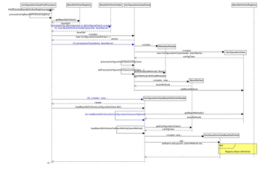
MyBatis中sql标签定义SQL片段,include标签引用,可以复用SQL片段
sql标签中id属性对应include标签中的refid属性。通过include标签将sql片段和原sql片段进行拼接成一个完整的sql语句进行执行。
|
1
2
3
4
5
6
7
8
|
<sql id="sqlid"> res_type_id,res_type</sql><select id="selectbyId" resultType="com.property.vo.PubResTypeVO"> select <include refid="sqlid"/> from pub_res_type</select> |
引用同一个xml中的sql片段
|
1
|
<include refid="sqlid"/> |
引用公用的sql片段
|
1
|
<include refid="namespace.sqlid"/> |
include标签中也可以用property标签,用以指定自定义属性。
在sql标签中通过${}取出对应的属性值。
|
1
2
3
4
5
6
7
8
9
|
<select id="queryPubResType" parameterType="com.property.vo.PubResTypeVO" resultMap="PubResTypeList"> select a.res_type_id, <include refid="com.common.dao.FunctionDao.SF_GET_LNG_RES_TYPE"> <property name="AI_RES_TYPE_ID" value="a.res_type_id"/> <property name="lng" value="#{lngId}"/> <property name="female" value="'女'"/> </include> as res_type from pub_res_type a</select> |
使用resultType进行输出映射,只有查询出来的列名和pojo中的属性名一致,该列才可以映射成功。
如果查询出来的列名和pojo的属性名不一致,通过定义一个resultMap对列名和pojo属性名之间作一个映射关系。
resultMap:适合使用返回值是自定义实体类的情况
resultType:适合使用返回值得数据类型是非自定义的,即jdk的提供的类型
补充:mybatis include标签传参特性测试
1 前言
mybatis的include标签主要是用于sql语句的可重用,并且可以接收参数来生成动态sql。为了进一步了解include标签的传参特性,我写了一段测试代码来测试一下include标签的特性。
2 测试代码
mapper.xml
|
1
2
3
4
5
6
7
8
9
10
11
12
13
14
15
16
17
18
19
20
21
22
23
24
25
26
27
28
29
30
31
32
33
34
35
36
|
<!--需要include的代码块--><sql id="luck"> #{luck}||'${luck}'</sql><!--property标签name属性和参数名一样,但值不同--><select id="test1" resultType="java.lang.String"> select <include refid="luck"> <property name="luck" value="lucktheuniverse"/> </include> from dual</select><!--property标签name属性和参数名一样,但值为#号方式传值--><select id="test2" resultType="java.lang.String"> select <include refid="luck"> <property name="luck" value="#{luck}"/> </include> from dual</select><!--property标签name属性和参数名一样,但值为$方式传值--><select id="test3" resultType="java.lang.String"> select <include refid="luck"> <property name="luck" value="${luck}"/> </include> from dual</select><!--property标签name属性和参数名不同--><select id="test4" resultType="java.lang.String"> select <include refid="luck"> <property name="luck1" value="lucktheuniverse"/> </include> from dual</select> |
mapper.java
|
1
2
3
4
|
String test1(@Param(value = "luck") String luck);String test2(@Param(value = "luck") String luck);String test3(@Param(value = "luck") String luck);String test4(@Param(value = "luck") String luck); |
test.java
|
1
2
3
4
|
String test1 = mapper.test1("luck123");String test2 = mapper.test2("luck123");String test3 = mapper.test1("luck123");String test4 = mapper.test2("luck123"); |
测试结果
|
1
2
3
4
|
test1: luck123lucktheuniversetest2: 报错test3: luck123luck123test4: luck123luck123 |
3 结论
1.采用${}取参数时,include标签的property属性的优先级要高于外围mapper的参数;
2.采用#{}取参数只能取到外围mapper传过来的参数。
4 test2报错原因
test2报错是因为,include中${luck}取了property中的#{luck},但是#{}自带了双引号。所以得到的sql就成了
|
1
|
select #{luck}||'#{luck}' from dual |
最终转化为preparedStatement,会报java.sql.SQLException: 无效的列索引
|
1
|
select ?||'?' from dual |
'?'是不能被单引号 ' 包围的
所以要谨慎,不要在#{}传入的参数周围加上单引号
把include代码块修改为,可以得到输出为luck123luck123
|
1
2
3
|
<sql id="luck">#{luck}||${luck}</sql> |
以上为个人经验,希望能给大家一个参考,也希望大家多多支持服务器之家。如有错误或未考虑完全的地方,望不吝赐教。
原文链接:https://www.cnblogs.com/yhgn/p/11187304.html













